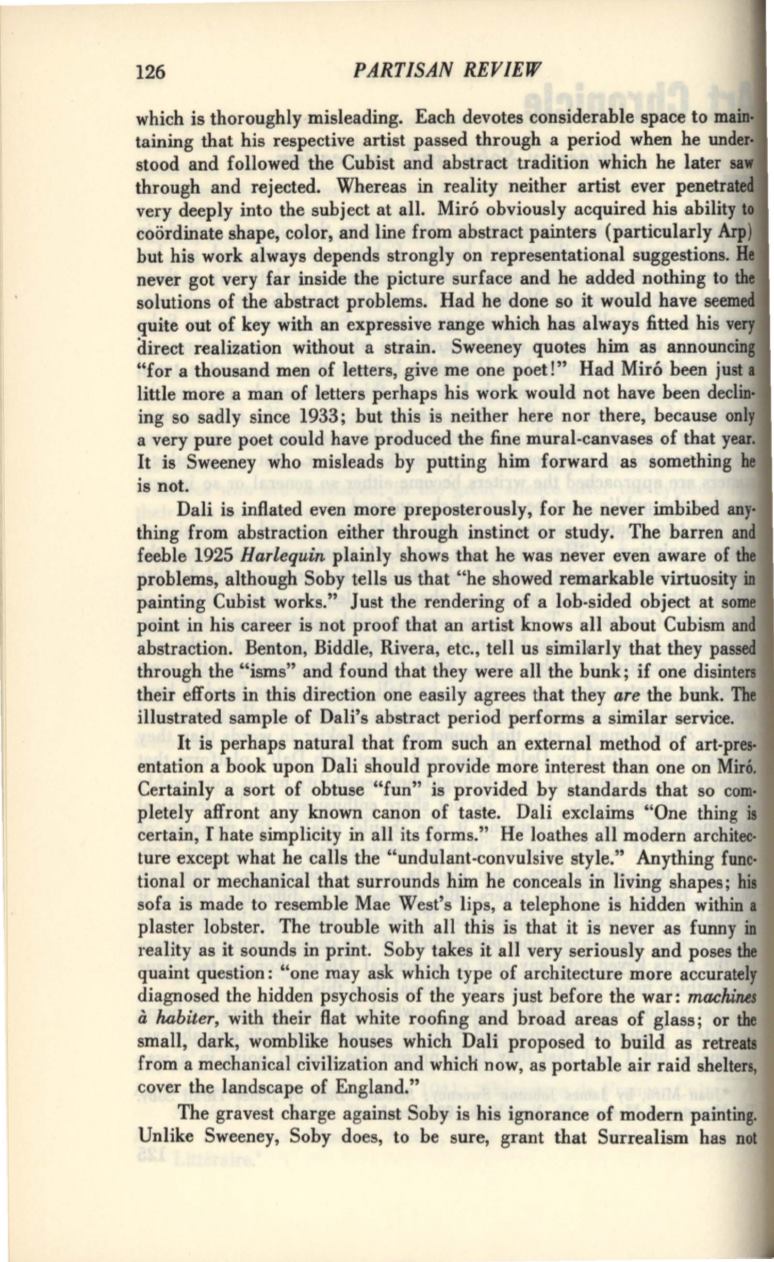
126
PARTISAN REVIEW
which is thoroughly misleading. Each devotes considerable space to main·
taining that his respective artist passed through a period when he under·
stood and followed the Cubist and abstract tradition which he later
saw
through and rejected. Whereas in reality neither artist ever penetrated
very deeply into the subject at all. Mire) obviously acquired his ability to
coordinate shape, color, and line from abstract painters (particularly
Arp)
but his work always depends strongly on representational suggestions. He
never got very far inside the picture surface and he added nothing to the
solutions of the ,abstract problems. Had he done so it would have seemed
quite out of key with an expressive range which has always fitted his very
direct realization without a strain. Sweeney quotes him as announcing
"for a thousand men of letters, give me one poet!" Had Mir6 been just a
little more a man of letters perhaps his work would not have been declin·
ing so sadly since 1933; but this is neither here nor there, because only
a very pure poet could have produced the fine mural-canvases of that
year.
It is Sweeney who misleads by putting him forward as something he
is not.
Dali is inflated even more preposterously, for he never imbibed any·
thing from abstraction either through instinct or study. The barren and
feeble 1925
Harlequin
plainly shows that he was never even aware of the
problems, although Soby tells us that "he showed remarkable virtuosity
in
painting Cubist works." Just the rendering of a lob-sided object at some
point in his career is not proof that an artist knows all about Cubism and
abstraction. Benton, Biddle, Rivera, etc., tell us similarly that they passed
through the "isms" and found that they were all the bunk; if one disinters
their efforts in this direction one easily agrees that they
are
the bunk. The
illustrated sample of Dali's abstract period performs a similar service.
It is perhaps natural that from such an external method of art-pres–
entation a book upon Dali should provide more interest than one on Mirci.
Certainly a sort of obtuse "fun" is provided by standards that so com·
pletely affront any known canon of taste. Dali exclaims "One thing
is
certain, I hate simplicity in all its forms." He loathes all modern architec·
ture except what he calls the "undulant-convulsive style." Anything func·
tiona! or mechanical that surrounds him he conceals in living shapes;
his
sofa is made to resemble Mae West's lips, a telephone is hidden within a
plaster lobster. The trouble with all this is that it is never as funny
in
reality as it sounds in print. Soby takes it all very seriously and poses the
quaint question: "one may ask which type of architecture more accurately
diagnosed the hidden psychosis of the years just before the war:
machina
a
habiter,
with their flat white roofing and broad areas of glass; or the
small, dark, womblike houses which Dali proposed to build as retreats
from a mechanical civilization and whicli now, as portable air raid shelters,
cover the landscape of England."
The gravest charge against Soby is his ignorance of modern painting.
Unlike Sweeney, Soby does, to be sure, grant that Surrealism has not


